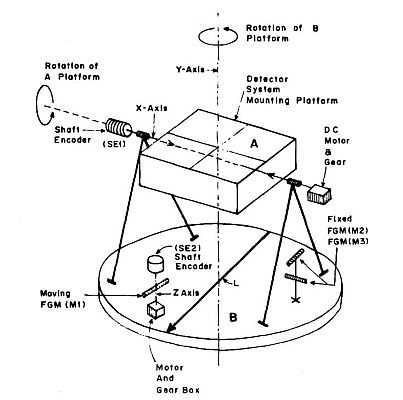Purpose of the flight and payload description
The TICAL X-Ray telescope consists of four NaI/CsI phoswich scintillator mounted on an altazimuth programmable orientation platform with celestial source tracking capability. The phoswich configuration enables the elimination of X-ray background produced by high energy atmospheric and cosmic gamma-rays. The telescope was built under a cooperation program between the Tata Institute of Fundamental research from India and the University of Calgary from Canada.
In the image at left we can see an scheme of the telescope (click to enlarge). The basic X-Ray detector system of the telescope was composed by four independent phoswich scintillators with 3 mm Nal(Tl) and 25 mm CsI(Na) crystals with good efficiency for detection of X-rays upto 120 keV. The total effective area was 400 cm2. Each detector was collimated to a field of view of 5° x 5° (FWHM) with slat collimators of copper and surrounded by a passive graded shield of lead, tin and copper to reduce the background. Each phoswich was viewed by a 12.5 cm diameter photomultiplier tube. Non X-ray background counts which appear as coincident Compton-scattered events in both the crystals were rejected by pulse width discrimination. Each photon energy was measured in 128 pulse height channels (upto 120 keV) and each pulse width in 128 channels and telemetered to ground. The photon arrival times were measured with a resolution of 0.16 ms. In-flight calibration was performed periodically by exposing the detectors to an Am 241 radioactive source to monitor the stability of the detectors and the associated electronics.
The telescope was mounted in a alt-azimuth system and has a programmed control for pointing in azimuth and elevation. An integrated assembly of detectors and electronic hardware was mounted on a servo-controlled main azimuth platform. The azimuth pointing employed a null-seeking servo system in which a reaction wheel control was used and the flux gate magnetmeter (FGM), Ml provided position sensing in the azimuth. Any deviation from the null (East-West direction) due to balloon perturbations, provided an output from Ml through servo amplifier to the torque motor, to regain the null position.
Ml was mounted on a turn-table driven by a stepper motor; a shaft encoder (SEI) provided instantenous position of Ml and hence the telescope azimuth. A geared servo motor provided a controlled drive for the elevation axis coupled to a shaft encoder (SE2) which provided the instantenous elevation aspect. An additional azimuth aspect was provided by a set of crossed FGM's M2 and M3. Thus SE1 and SE2 together withn M2 and M3 provided complete aspect information for the X-ray telescope. The pointing accuracy achieved was 0.35 degrees in azimuth and elevation.
During flight, the elevation control motor and the stepper motor of the turntable with Ml could be driven through remote control or through commands generated by an onboard position control programmer (PCP). This scheme facilitated a programmed observation of celestial X-ray sources and corresponding background.
Details of the balloon flight
Balloon launched on: 12/18/1984 at 8:50 IST
Launch site: TIFR National Balloon Facility, Hyderabad, India
Balloon launched by: National Balloon Facility, Tata Institute of Fundamental Research
Balloon manufacturer/size/composition: Zero Pressure Balloon Winzen Stratofilm (tow+main) 173.000 m3
Flight identification number: 375
End of flight (L for landing time, W for last contact, otherwise termination time): 12/18/1984 at 16:30 IST
Balloon flight duration (F: time at float only, otherwise total flight time in d:days / h:hours or m:minutes - ): 10 h
Payload weight: 474 kgs
Overall weight: 838 kgs
During the ten hour flight several galactic X-ray sources were tracked by the telescope using the on-board microprocessor. Fluxes and spectra in 18-120 keV X-rays for SCO X-I, GX I+4, GX 5-I, GX 17+2, SCT X-I , CYG X-I and CYG X-3 were obtained.
External references
- A high sensitivity phoswich scintillator X-ray telescope for hard X-ray (20-120 keV) astronomy from balloon platform Advances in Space Research, vol. 7, no. 7, 1987, p. 115
- Balloon Flight Report 1969 -2003 TIFR website (via Archive.Org)
- Balloon observations of hard X-rays from some galactic X-ray sources NASA. Goddard Space Flight Center 19th Intern. Cosmic Ray Conf., Vol. 1; p 229
- Detection of 2.93 MS pulsations in SCO X-1 23rd ESLAB Symposium on Two Topics in X Ray Astronomy. Volume 1: X Ray Binaries p 377
- High energy X-ray timing and spectral observations of SCO X-1, CYG X-1, GX 5-1, CYG X-3 and GX 1+4 Advances in Space Research, vol. 8, no. 2-3, 1988, p. 415
1019If you consider this website interesting or useful, you can help me to keep it up and running with a small donation to cover the operational costs. Just the equivalent of the price of a cup of coffee helps a lot.


